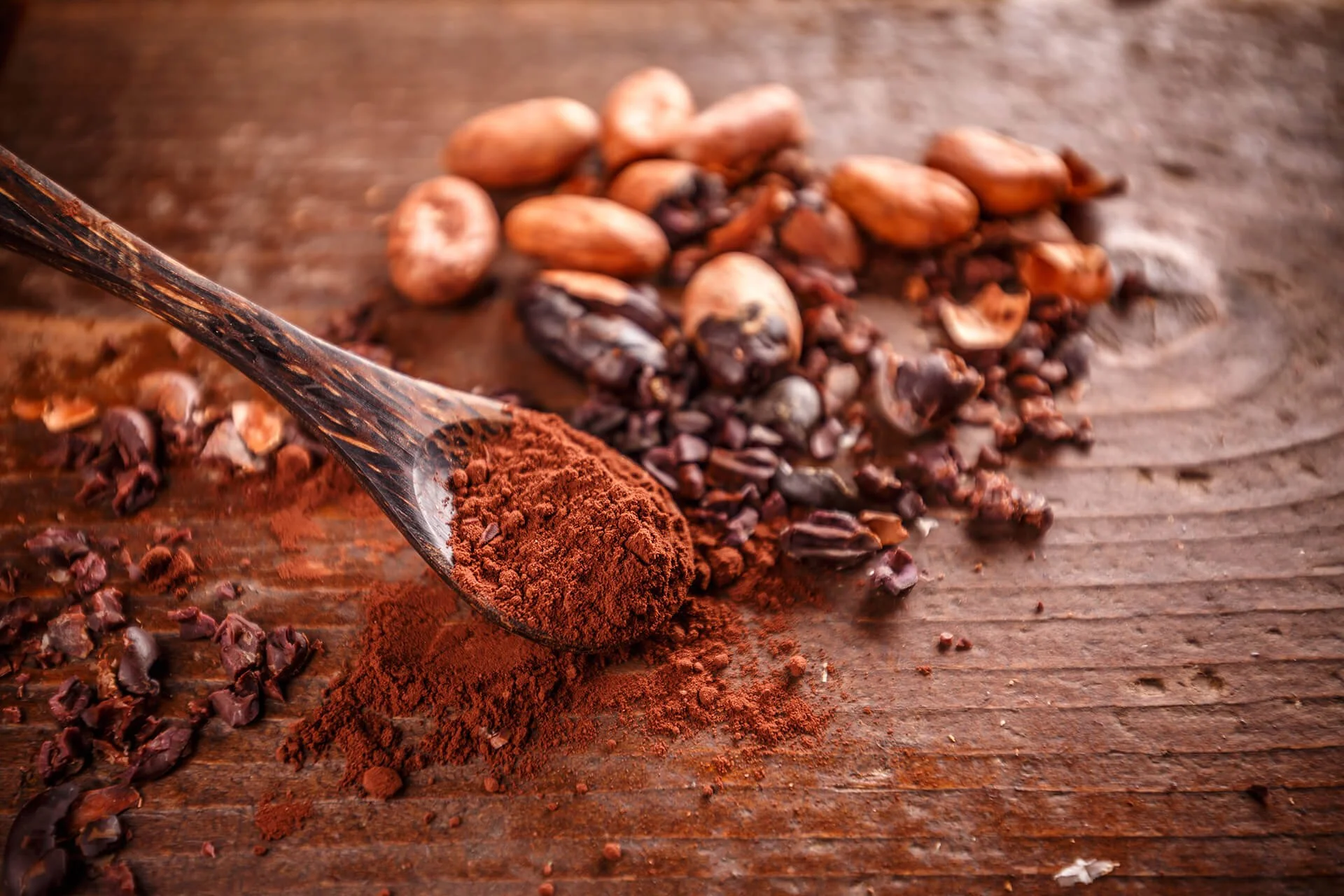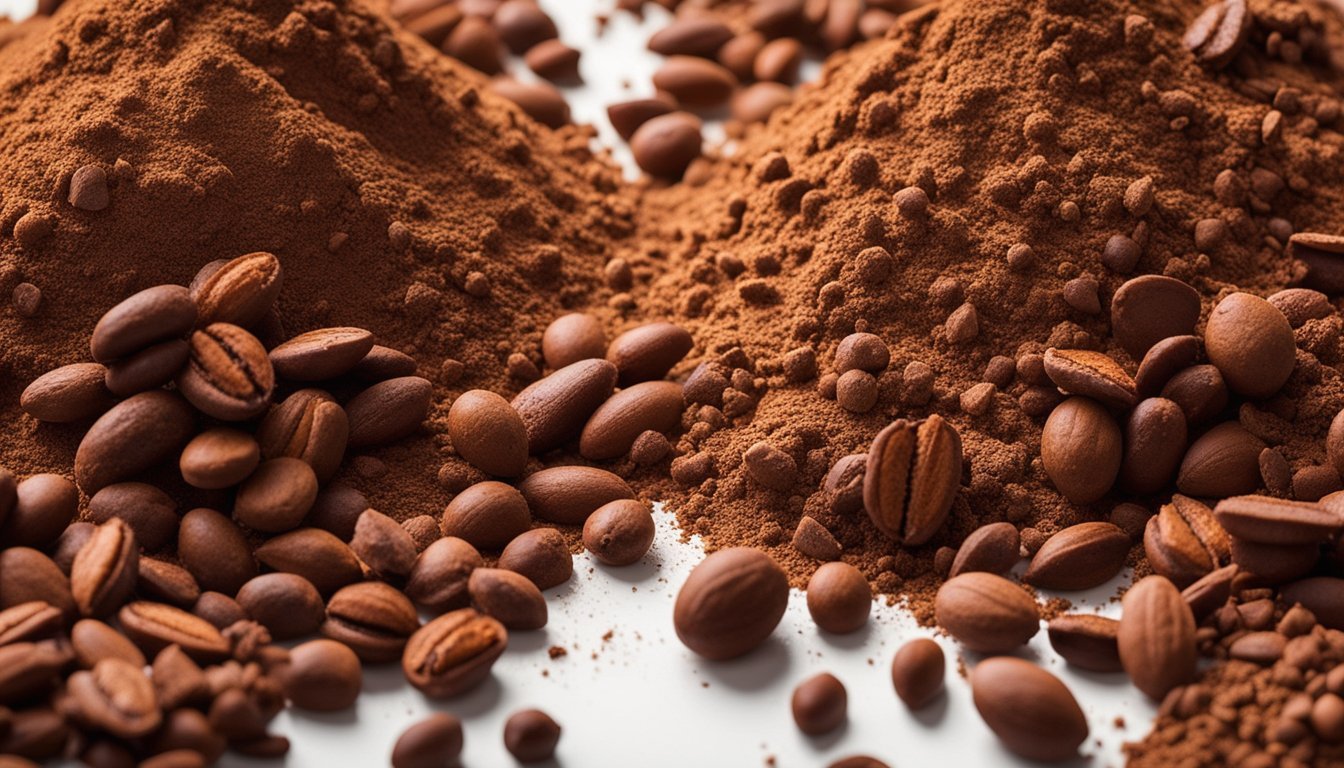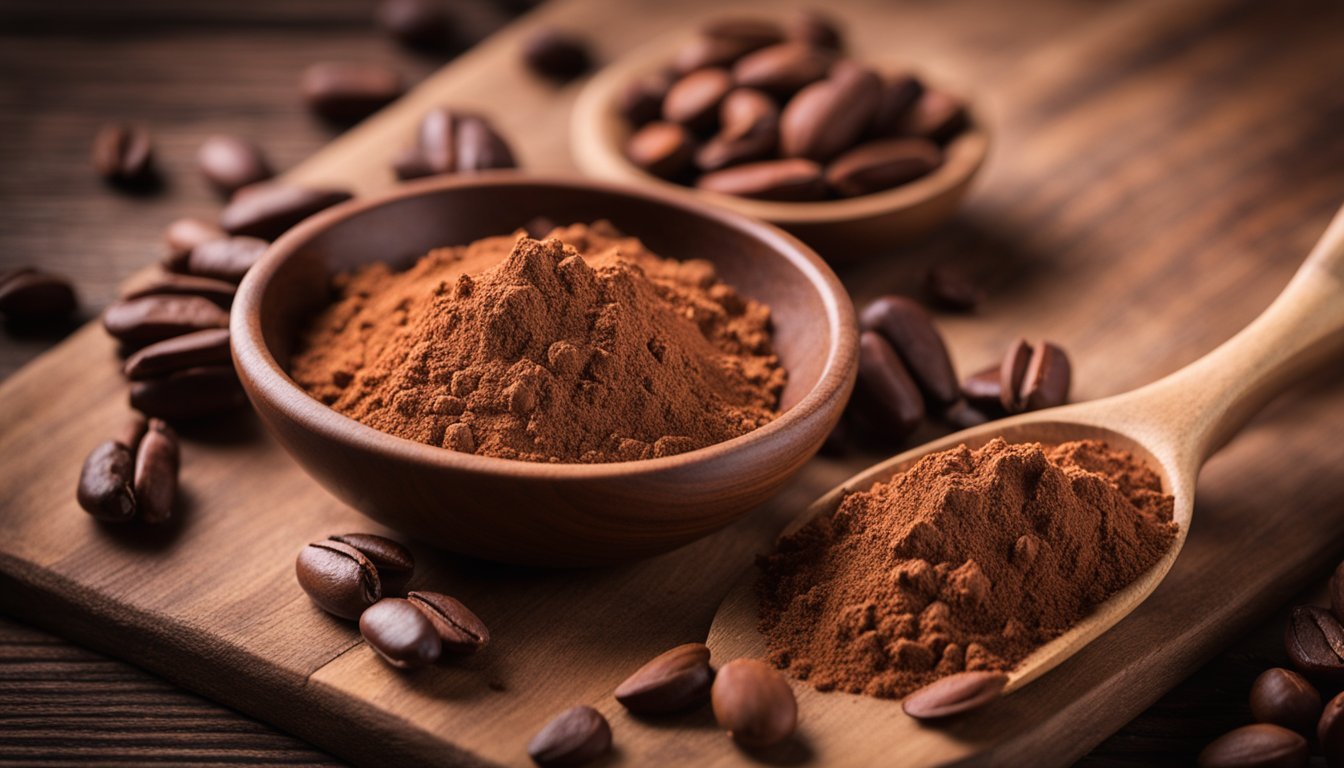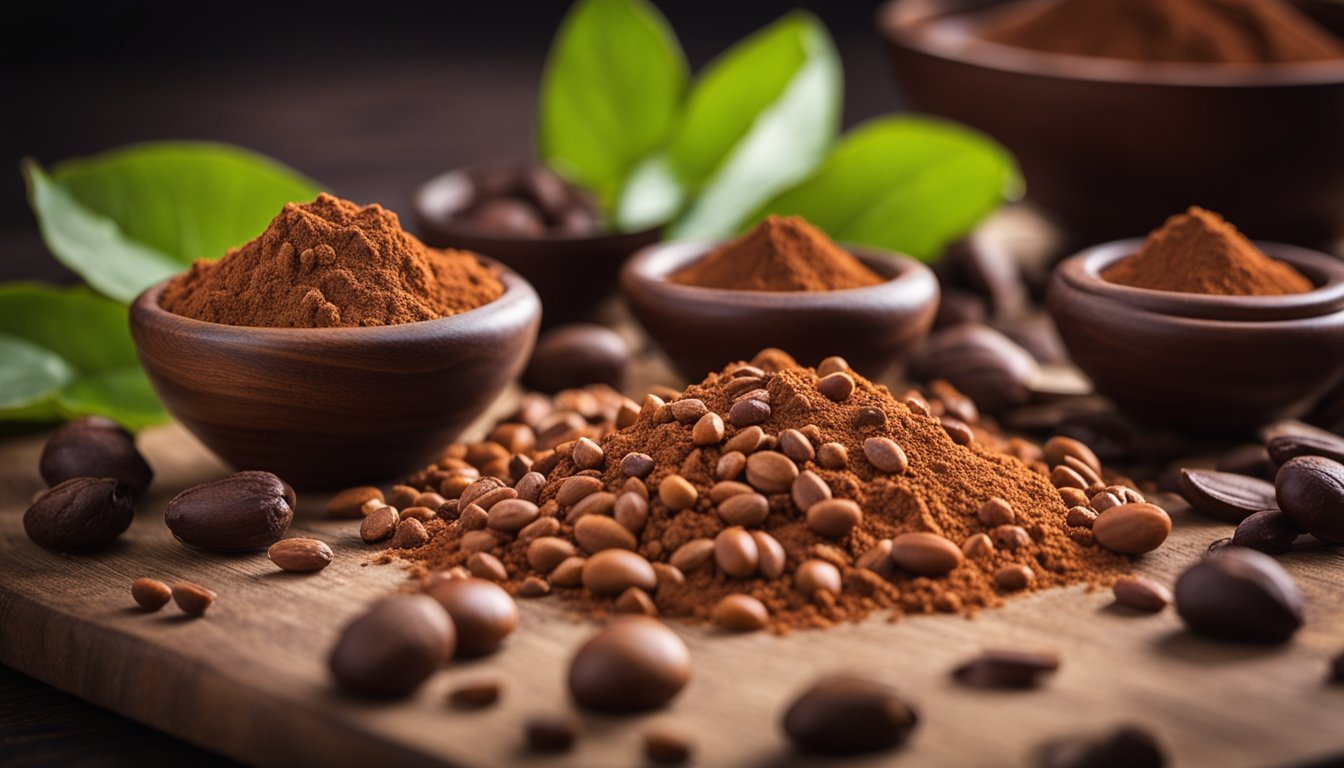Health Benefits of Raw Cacao vs Cocoa Powder
A Comprehensive Comparison
Discover > Healthy Living Through Food > Health Benefits of Raw Cacao vs Cocoa Powder
Raw cacao and cocoa powder are both derived from the cacao bean, which grows on the Theobroma cacao tree. The Mayans were the first to cultivate the cacao tree and use the beans to make a bitter drink. Today, cocoa and chocolate (What wine goes well with chocolate?) are enjoyed worldwide in various forms, including milk chocolate, dark chocolate, and cacao nibs (how long do cacao nibs last?).
Raw cacao is made by cold-pressing unroasted cacao beans. This process preserves the enzymes and nutrients in the cacao, which can be lost during roasting. Cocoa powder, on the other hand, is made by grinding roasted cacao beans into a fine powder. While both raw cacao and cocoa powder are used in cooking and baking, raw cacao is often considered a superfood due to its high nutrient content.
Raw cacao and cocoa powder are both derived from the cacao pod, but they differ in their processing methods. Raw cacao is made by cold-pressing unroasted cacao beans, which preserves its antioxidant properties and bitter taste. Cocoa powder, on the other hand, is made by roasting cacao beans at high temperatures, which can diminish its antioxidant properties and impart a milder taste. Raw cacao can be found in health food stores and can be used to make hot chocolates and other cocoa products that promote human health. Unsweetened cocoa powder, on the other hand, is often used in baking and cooking as a milder alternative.
Understanding Cacao and Cocoa
Cacao and cocoa are often used interchangeably, but they are not the same thing. Cacao refers to the raw, unprocessed beans from the Theobroma cacao tree, while cocoa refers to the beans that have been roasted, fermented, and processed into a powder or solid form.
Processing of Cacao and Cocoa
The processing of cacao and cocoa involves several steps, including fermentation, roasting, drying, grinding, pressing, and winnowing. Fermentation is a crucial step in which the beans are placed in boxes or baskets to ferment for several days, allowing enzymes to break down the pulp surrounding the beans and develop the flavor. After fermentation, the beans are roasted to develop a rich, chocolatey flavor and aroma. The roasted beans are then dried, ground, and pressed to separate the cocoa solids from the cocoa butter. (how long does cocoa butter last?) Finally, the cocoa solids are crushed and winnowed to create cocoa powder.
Historical Context
The use of cacao dates back to the ancient Mayans, who consumed cacao as a beverage. They believed that cacao had medicinal properties and used it in religious ceremonies. When the Spanish arrived in the Americas, they brought cacao back to Europe, where it gained popularity as a luxury item. Over time, the processing of cacao evolved, and cocoa powder became a staple ingredient in many recipes.
Today, there are several types of cocoa and cacao products available, including raw cacao powder, cocoa powder, cacao nibs, and cocoa butter. Raw cacao powder is made from unroasted cacao beans and is considered to be a more natural form of chocolate. Cocoa powder, on the other hand, is made from roasted beans and is often used in baking and cooking.
Overall, understanding the differences between cacao and cocoa is important when choosing products for their health benefits. While both offer benefits, raw cacao is considered to be the healthier option due to its higher nutrient content and lack of processing.
Nutritional Value and Health Benefits
Raw cacao and cocoa powder are both derived from the same source, the Theobroma cacao tree, but differ in their processing methods. Raw cacao is made by cold-pressing unroasted cocoa beans, while cocoa powder is made by roasting and processing cocoa beans at high temperatures. This processing difference affects the nutritional value and health benefits of the two products.
The raw cacao bean is the purest form of chocolate that comes from the cacao plant. They are often compared to cocoa powder, which undergoes Dutch processing, a process that involves alkalizing cocoa to reduce its acidity. Raw cacao beans usually require minimal processing, which helps to preserve their nutritional benefits.
Raw cacao beans are an excellent source of magnesium, antioxidants, and flavonoids, which can help to improve cardiovascular health. They are also a good source of iron, which is essential for building healthy red blood cells. Additionally, raw cacao beans have been shown to improve cognitive performance.
Unsweetened chocolate, also known as baking chocolate (how long does baking chocolate last?), is made from ground cocoa beans and is another source of flavonoids. However, it is important to note that unsweetened chocolate may contain added fat and sugar.
In general, the aspect of cacao vs. cocoa, raw cacao beans are considered to be a healthier option than cocoa powder or sweetened chocolate due to their minimal processing and higher nutrient content. So, if you're looking for a healthier alternative, raw cacao beans may be worth considering.
Minerals and Nutrients
Raw cacao and cocoa powder are both rich in minerals and nutrients, including magnesium, iron, manganese, copper, potassium, zinc, fiber, and protein. Raw cacao has higher amounts of these minerals and nutrients than cocoa powder since it undergoes less processing. For example, one ounce of raw cacao nibs contains 64 milligrams of magnesium, while one ounce of cocoa powder contains only 23 milligrams.
Antioxidants and Flavanols
Both raw cacao and cocoa powder are rich in antioxidants, which help to protect the body against damage from free radicals. Raw cacao has higher amounts of antioxidants than cocoa powder since it undergoes less processing. Raw cacao is also rich in flavanols, a type of antioxidant that has been shown to have numerous health benefits, including reducing inflammation, improving blood flow, and lowering blood pressure. One study found that consuming a high-flavanol cocoa drink improved cognitive function in older adults.
Calories and Macronutrients
Raw cacao and cocoa powder are both high in fat, but the fat in raw cacao is primarily cacao butter, (how long does cacao butter last?) which is a healthy fat that contains oleic acid, a monounsaturated fat that has been shown to lower cholesterol levels. Raw cacao also contains fewer calories and carbohydrates than cocoa powder, making it a better option for those watching their calorie intake. One ounce of raw cacao nibs contains 140 calories and 9 grams of carbohydrates, while one ounce of cocoa powder contains 120 calories and 14 grams of carbohydrates.
In summary, both raw cacao and cocoa powder have nutritional value and health benefits, but raw cacao is generally more nutrient-dense and has higher amounts of antioxidants and flavanols. However, cocoa powder is still a good source of antioxidants and can be a more convenient option for use in baking and cooking.
Potential Health Risks
While raw cacao and cocoa powder offer many potential health benefits, there are also some potential health risks associated with their consumption. It is important to be aware of these risks and to consume these products in moderation.
Sugar and Fat Content
Many commercially available cocoa powders and chocolate products contain added sugar and fat, which can contribute to weight gain and other health issues when consumed in excess. It is important to read the labels carefully and choose products with minimal added sugars and fats.
Caffeine and Theobromine
Both raw cacao and cocoa powder contain caffeine and theobromine, which can have stimulant effects on the body. While these compounds can provide a boost of energy and improve mental focus, excessive consumption can lead to negative side effects such as insomnia, anxiety, and digestive issues.
Consumption Moderation
Consuming raw cacao and cocoa powder in moderation is key to avoiding potential health risks. While these products can provide many health benefits, excessive consumption can lead to negative side effects. It is recommended to limit consumption to a few ounces per day and to avoid consuming these products late in the day to avoid disrupting sleep patterns.
Overall, while there are potential health risks associated with raw cacao and cocoa powder consumption, these risks can be minimized through moderation and careful product selection. By choosing products with minimal added sugars and fats and consuming these products in moderation, individuals can enjoy the many potential health benefits of these products without putting their health at risk.
Cacao and Cocoa in Diet
Cacao and cocoa are versatile ingredients that can be easily incorporated into various meals and snacks. Here are some ways to enjoy the health benefits of cacao and cocoa:
Incorporating in Meals and Snacks
Smoothies: Adding cacao or cocoa powder to smoothies can create a rich and chocolatey flavor. Blend with fruits, nuts, or milk for a delicious and nutritious breakfast or snack.
Tea: Cacao shells or cocoa nibs can be brewed into tea for a warm and comforting beverage.
Yogurt: Mix cacao or cocoa powder into plain yogurt for a chocolatey twist on a healthy snack.
Fruits and Nuts: Dip fruits and nuts in melted dark chocolate for a satisfying and antioxidant-rich snack.
Baking with Cacao and Cocoa
Brownies: Use cacao or cocoa powder in brownie recipes for a decadent and healthier dessert option.
Cookies: Add cacao nibs or chocolate chips (how long do chocolate chips last?) to cookie recipes for a crunchy and chocolatey twist.
Cakes: Use cacao or cocoa powder in cake recipes for a rich and moist chocolate cake.
Cacao and Cocoa in Vegan Diet
Cacao and cocoa are great options for those following a vegan diet. They can be used in place of dairy products and still provide a rich and creamy texture. Some examples include:
Chocolate Avocado Mousse: Blend cacao powder, avocado, and sweetener for a creamy and healthy dessert.
Chocolate Pea Protein Smoothie: Blend cacao powder, pea protein powder, (how long does protein powder last?) and almond milk (how long does almond milk last?) for a protein-packed breakfast or snack.
Vegan Chocolate Truffles (What wine goes well with truffles?): Mix melted cocoa butter, cacao powder, and sweetener for a rich and indulgent treat.
Overall, cacao and cocoa can be enjoyed in many different ways and provide numerous health benefits. Incorporating them into your diet can be a delicious and nutritious choice.
Impact on Chronic Diseases
Raw cacao and cocoa powder have been studied for their potential impact on chronic diseases, including heart disease, diabetes, and neurodegenerative diseases. While more research is needed to fully understand the effects, some studies have shown promising results.
Heart and Blood Pressure
Studies have suggested that consuming raw cacao or cocoa powder may have a positive impact on heart health and blood pressure. One study found that consuming cocoa powder daily for eight weeks resulted in a significant decrease in blood pressure in individuals with high blood pressure. Another study found that consuming dark chocolate, which contains raw cacao, may improve blood flow and reduce the risk of heart attack and stroke.
Diabetes and Insulin Resistance
Raw cacao and cocoa powder may also have a potential impact on diabetes and insulin resistance. One study found that consuming cocoa powder daily for four weeks resulted in improved insulin sensitivity in individuals with type 2 diabetes. Another study found that consuming dark chocolate may improve blood sugar control and reduce inflammation in individuals with type 2 diabetes.
Brain Health and Neurodegenerative Diseases
Some studies have suggested that consuming raw cacao or cocoa powder may have a positive impact on brain health and reduce the risk of neurodegenerative diseases such as Alzheimer's. One study found that consuming cocoa flavanols, which are found in raw cacao, may improve cognitive function and increase blood flow to the brain in older adults. Another study found that consuming cocoa flavanols may improve cognitive function in individuals with mild cognitive impairment.
Overall, while more research is needed to fully understand the impact of raw cacao and cocoa powder on chronic diseases, some studies have suggested potential benefits. It is important to note that raw cacao and cocoa powder should be consumed in moderation as they can be high in calories and sugar.






